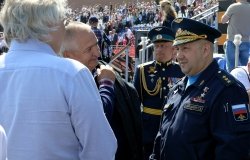Armed Drones Revolutionized Airpower
The success of the armed Predator has sparked a revolution in unmanned aircraft, making it “arguably the most important new military technology since the nuclear-armed intercontinental ballistic missile,” according to a paper by Wilson Center Senior Scholar Richard Whittle.
The success of the armed Predator has sparked a revolution in unmanned aircraft, making it “arguably the most important new military technology since the nuclear-armed intercontinental ballistic missile,” according to a paper by Wilson Center Senior Scholar Richard Whittle.
Whittle details how an office of the Air Force known as “Big Safari” put Hellfire anti-tank missiles on the previously unarmed Predator, transforming the surveillance drone into a weapon that was subsequently used by the CIA in Afghanistan beginning in 2001 and in other countries since. The move followed the Kosovo air war of 1999, during which Air Force commanders were frustrated by the inability of manned aircraft flying under high altitude restrictions to find and attack Serb military targets. The project to arm the drones gained momentum dramatically after the CIA used unarmed Predators to search for Osama bin Laden in Afghanistan in the fall of 2000 – missions flown by Air Force crews, Whittle reveals – and spotted him twice but had no way to attack the mastermind of the 1998 U.S. embassy bombings in Kenya and Tanzania.
The armed Predator went into use days after the terrorist attacks of Sept. 11, 2001, when an Air Force crew seated in a ground control station on the parking lot at CIA headquarters in northern Virginia began flying the new weapon over Afghanistan. On the night the Afghan War began, Oct. 7, 2001, that crew fired the first missile launched in combat by the Predator, inaugurating a new age in warfare.
The paper, published by the Air Force Association’s think tank, The Mitchell Institute for Airpower Studies, is available in full on The Mitchell Institute’s website at http://www.afa.org/Mitchell/Reports/MP7_Predator_0811.pdf.
Richard Whittle, who is also a Visiting Scholar at Johns Hopkins University’s School of Advanced International Studies and author of The Dream Machine: The Untold History of the Notorious V-22 Osprey, is available for interviews.










